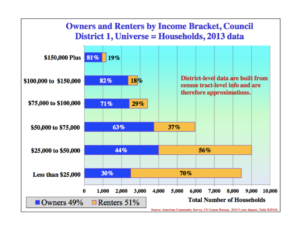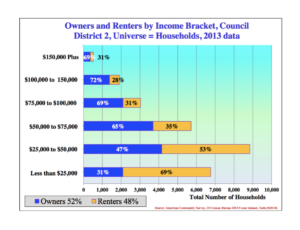To: Interested Parties
From: Jason Stanford, Office of the Mayor
Date: July 8, 2016
Re: Whom we helped by upping the homestead exemption
In June, the City Council approved on third reading Ordinance No. 20150604-101, increasing the homestead exemption by 2% to 8%. The projected total savings to Austin homeowners is $3.8 million. Raising the homestead exemption by 2% will save the owner of a $250,000 an extra $22.95 a year.
Questions have been raised, however, about who benefits most from cutting the taxes on Austin homeowners. This memo attempts to address those questions.
PROPERTY TAXES ARE REGRESSIVE…
The property tax is a regressive tax because it takes a higher percentage of income from lower income homeowners than from wealthier ones. Cutting the property tax proportionally, as a homestead exemption increase does, does not increase the degree to which the tax is regressive.
…SO A HOMESTEAD EXEMPTION IS PROGRESSIVE
Because a property tax takes proportionately more from lower-income homeowners than higher-income ones, then it follows that cutting those taxes by a set percentage benefits homeowners more the lower they fall on the income scale because they recover a greater share of their income.
BUT ARE THERE LOWER-INCOME HOMEOWNERS?
Yes. According to census data, in 2013 Austin had 73,000 housing units with an annual household income of less than $25,000. Shockingly, 20 percent of those were owner-occupied.
Also, there were 84,000 housing units with a household income between $25,000 and $50,000. Of those, 29 percent of those units were owner-occupied.
WHERE ARE THESE LOWER-INCOME HOMEOWNERS?
 Primarily, these lower-income homeowners are clustered in council districts 1 and 2 but can be found throughout the city. In the under-$25,000 income bracket, we find:
Primarily, these lower-income homeowners are clustered in council districts 1 and 2 but can be found throughout the city. In the under-$25,000 income bracket, we find:
- Only districts 1 and 2 had more than 2,000 low-income homeowners.
- Only district 9 had fewer than 1,000.
- The remainder had between 1,000 and 2,000 such homeowners.
In the $25,000-$50,000 income bracket, we see these homeowners clustered first in districts 1  and 2, followed by districts 5 and 7.
and 2, followed by districts 5 and 7.
- In districts 1 and 2, the number of homeowners in the $25,000-$50,000 range top 4,000, more than the number of homeowners making more than $100,000 or more a year in each district.
- In districts 4, 5, and 7, the number of homeowners in the $25,000-$50,000 range exceeds the number of the homeowners making more than $150,000 a year.
- Only in districts 6, 8, 9, and 10 do the number of wealthier homeowners exceed the number of middle- and lower-income homeowners.

